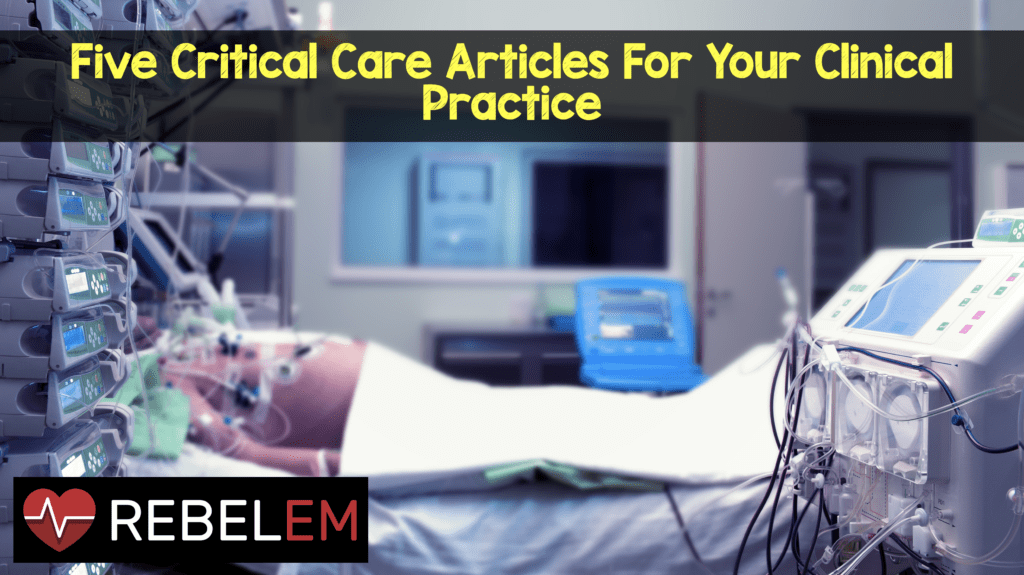
 Critical illness is a life-threatening multisystem process that can result in significant morbidity and mortality. Timely, appropriate, and effective care for these patients is something all emergency physicians strive for. Using data from clinical trials of previous years, we can improve patient management and outcomes. In this post, I list my five critical care articles for your clinical practice in the care of these patients.
Critical illness is a life-threatening multisystem process that can result in significant morbidity and mortality. Timely, appropriate, and effective care for these patients is something all emergency physicians strive for. Using data from clinical trials of previous years, we can improve patient management and outcomes. In this post, I list my five critical care articles for your clinical practice in the care of these patients.
The CORTICUS Trial [1]
 What they did:
What they did:
- Multicenter, randomized, double-blind, placebo-controlled trial of 499 patients with septic shock
- 50mg IV hydrocortisone vs placebo every 6 hours for 5 days
- Primary outcome of death at 28 days for pts with no response to a corticotropin stimulation test
Results:
- No significant difference in mortality between the two groups (39.2% vs 36.1% with a p value of 0.69)
- Shock was reversed more quickly in the hydrocortisone group, but with more episodes of new infections (3.3 vs 5.8 days)
Limitation: Study was underpowered (needed 800 patients to be powered correctly)
Conclusion: Hydrocortisone therapy does not improve survival in patients with septic shock, but may reduce duration of vasopressor dependence.
The NICESUGAR Trial [2]
 What they did:
What they did:
- International, parallel-group, randomized control trial at 42 hospitals
- 6104 patients in an ICU setting
- Intensive glucose control (81 – 108 mg/dL) vs Conventional glucose control (< 180 mg/dL)
- Primary endpoint of death at 90 days
Results:
- Death rate at 90 days of 27.5% in intensive control group vs 24.9% in conventional control group
- Severe hypoglycemia in 6.8% in intensive control group vs 0.5% in conventional control group
- No significant difference in length of stay in ICU or number of days on mechanical ventilation
Conclusion: Intensive glucose control (81 – 108 mg/dL) increased mortality among adults in the ICU vs conventional glucose control (< 180 mg/dL)
The ARDSNet Trial [3]
 What they did:
What they did:
- Multicenter, randomized control trial
- 861 patients with acute lung injury and/or acute respiratory distress syndrome
- Traditional ventilation (Tidal volume of 12 ml/kg of predicted body weight and a plateau pressure of ≤50 cm H2O) vs ventilation with a lower tidal volume (Tidal volume of 6 ml/kg of predicted body weight and a plateau pressure of ≤30 cm H2O)
- Primary outcomes of death and days without ventilator
Results:
- Trial was stopped early due to drastic mortality benefit from lower tidal volume
- Mortality: Lower TV (31%) vs Traditional TV (39.8%)
- More ventilator free days in the lower tidal volume group (12 vs 10 days)
Conclusion: Lower tidal volume (6mL/kg of predicted body weight) in patients with acute lung injury and acute respiratory distress syndrome results in decreased mortality and decreased number of days on the ventilator.
The SOAP II Trial [4]
 What they did:
What they did:
- Multicenter, randomized clinical trial of 1679 patients with shock
- Dopamine vs Norepinephrine as first-line vasopressor therapy
- Primary outcome was rate of death at 28 days
Results:
- No statistical difference in mortality (52.5% vs 48.5% with p value of 0.10)
- More arrythmogenic events in the dopamine group (24.1%) vs the norepinephrine group (12.4%)
- Sub-group analysis of patients with cardiogenic shock showed a higher mortality rate with the use of dopamine vs norepinephrine
Conclusion: In patients with shock, the use of dopamine as a first-line vasopressor agent is associated with greater number of adverse events vs norepinephrine.
The VASST Trial [cite source=”pubmed”]18305265[/cite]
 What they did:
What they did:
- Multicenter, randomized, double-blind trial of 778 patients with septic shock
- Addition of Vasopressin or additional Norepinephrine in patients with septic shock requiring at least 5 mcg/min of norepinephrine
- Primary outcome of mortality rate at 28 days
Results:
- No statistical difference (p value of 0.26) in mortality between Vasopressin (35.4%) vs additional Norepinephrine (39.3%)
- No statistical difference in serious adverse events between the two agents
Conclusion: Vasopressin is comparable to additional norepinephrine when added to norepinephrine therapy in patients with septic shock.
Summary of Five Critical Care Articles For Your Clinical Practice:
- Hydrocortisone therapy does not improve survival in patients with septic shock
- Intensive glucose control increased mortality among adults in the ICU
- Lower tidal volume in patients with ALI and ARDS results in decreased mortality and number of days on the ventilator
- In patients with shock, norepinephrine is the vasopressor of choice
- In patients with septic shock, vasopressin added to norepinephrine can decrease the amount of norepinephrine required
References:
- Sprung CL et al. Hydrocortisone Therapy for Patients with Septic Shock. NEJM 2008. PMID: 18184957
- NICE-SUGAR Study Investigators. Intensive Versus Conventional Glucose Control in Critically Ill Patients. NEJM 2009. PMID: 19318384
- Acute Respiratory Distress Syndrome Network. Ventilation with Lower Tidal Volumes as compared with Traditional Tidal Volumes for Acute Lung Injury and the Acute Respiratory Distress Syndrome. NEJM 2000. PMID: 10793162
- De Backer D et al. Comparison of Dopamine and Norepinephrine in the Treatment of Shock. NEJM 2010. PMID: 20200382
- Russell JA et al. Vasopressin Versus Norepinephrine Infusion in Patients with Septic Shock. NEJM 2008. PMID: 18305265
The post Five Critical Care Articles For Your Clinical Practice appeared first on REBEL EM - Emergency Medicine Blog.
